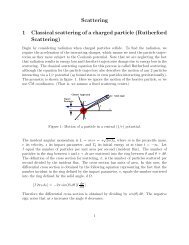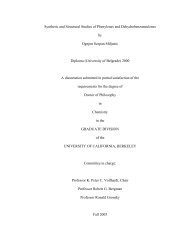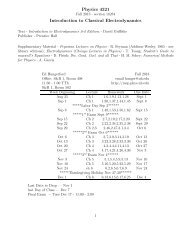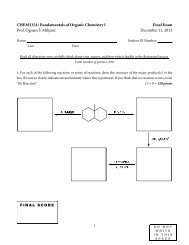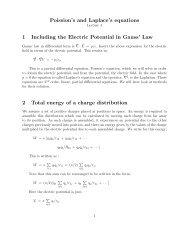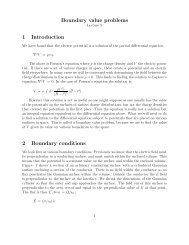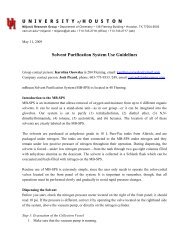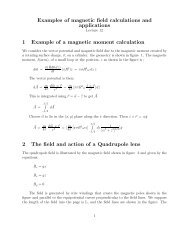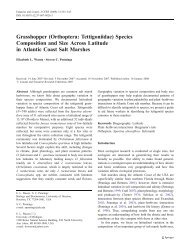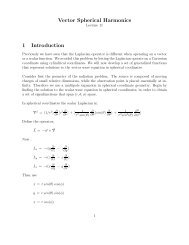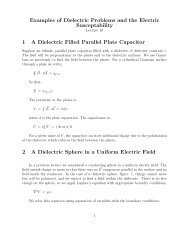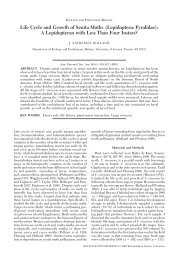Kang et al. PNAS (2009) - Center for Nuclear Receptors and Cell ...
Kang et al. PNAS (2009) - Center for Nuclear Receptors and Cell ...
Kang et al. PNAS (2009) - Center for Nuclear Receptors and Cell ...
- No tags were found...
Create successful ePaper yourself
Turn your PDF publications into a flip-book with our unique Google optimized e-Paper software.
The Corynebacterium diphtheriae shaft pilin SpaAis built of t<strong>and</strong>em Ig-like modules with stabilizingisopeptide <strong>and</strong> disulfide bondsHae Joo <strong>Kang</strong> a , Neil G. Paterson a , Andrew H. Gaspar b , Hung Ton-That b,c,1 , <strong>and</strong> Edward N. Baker a,1a Maurice Wilkins Centre <strong>for</strong> Molecular Biodiscovery <strong>and</strong> School of Biologic<strong>al</strong> Sciences, University of Auckl<strong>and</strong>, Auckl<strong>and</strong> 1020, New Ze<strong>al</strong><strong>and</strong>; b Departmentof Molecular, Microbi<strong>al</strong>, <strong>and</strong> Structur<strong>al</strong> Biology, University of Connecticut He<strong>al</strong>th <strong>Center</strong>, Farmington, CT 06030; <strong>and</strong> c Department of Microbiology<strong>and</strong> Molecular Gen<strong>et</strong>ics, University of Texas He<strong>al</strong>th Science <strong>Center</strong>, Houston, TX 77030Edited by David S. Eisenberg, University of C<strong>al</strong>i<strong>for</strong>nia, Los Angeles, CA, <strong>and</strong> approved August 12, <strong>2009</strong> (received <strong>for</strong> review June 17, <strong>2009</strong>)<strong>Cell</strong>-surface pili are important virulence factors that enable bacteri<strong>al</strong>pathogens to adhere to specific host tissues <strong>and</strong> modulate hostimmune response. Relatively little is known about the structure ofGram-positive bacteri<strong>al</strong> pili, which are built by the sortase-cat<strong>al</strong>yzedcov<strong>al</strong>ent crosslinking of individu<strong>al</strong> pilin proteins. Here we report the1.6-Å resolution cryst<strong>al</strong> structure of the shaft pilin component SpaAfrom Corynebacterium diphtheriae, reve<strong>al</strong>ing both common <strong>and</strong>unique features. The SpaA pilin comprises 3 t<strong>and</strong>em Ig-like domains,with characteristic folds related to those typic<strong>al</strong>ly found in non-pilusadhesins. Whereas both the middle <strong>and</strong> the C-termin<strong>al</strong> domainscontain an intramolecular Lys–Asn isopeptide bond, previously d<strong>et</strong>ectedin the shaft pilins of Streptococcus pyogenes <strong>and</strong> Bacilluscereus, the middle Ig-like domain <strong>al</strong>so harbors a c<strong>al</strong>cium ion, <strong>and</strong> theC-termin<strong>al</strong> domain contains a disulfide bond. By mass spectrom<strong>et</strong>ry,we show that the SpaA monomers are cross-linked in the assembledpili by a Lys–Thr isopeptide bond, as predicted by previous gen<strong>et</strong>icstudies. Tog<strong>et</strong>her, our results reve<strong>al</strong> that despite profound dissimilaritiesin primary sequences, the shaft pilins of Gram-positive pathogenshave strikingly similar tertiary structures, suggesting a modularbackbone construction, including stabilizing intermolecular <strong>and</strong> intramolecularisopeptide bonds.cryst<strong>al</strong> structure polymerization bacteri<strong>al</strong> pilus mass spectrom<strong>et</strong>ry pilin motifPili are long, thin protein assemblies that extend from the cellsurface of many bacteria <strong>and</strong> play pivot<strong>al</strong> roles in colonization<strong>and</strong> pathogenesis. Like Gram-negative bacteria, manyGram-positive pathogens express pili on their surface (1–3).These structures have aroused great interest because of theirdirect roles in infection <strong>and</strong> pathogenesis <strong>and</strong> their importanceas vaccine c<strong>and</strong>idates (2, 3). They <strong>al</strong>so use cov<strong>al</strong>ent isopeptide(amide) bonds, both intermolecular <strong>and</strong> intramolecular, to givestrength <strong>and</strong> stability, <strong>and</strong> thus present a new paradigm amongprotein polymers (4–6).Unlike Gram-negative pili, whose subunits associate via noncov<strong>al</strong>entinteractions, these Gram-positive pili are <strong>for</strong>med bycov<strong>al</strong>ent polymerization of pilin subunits, orchestrated bytranspeptidase enzymes c<strong>al</strong>led sortases (6, 7). The gener<strong>al</strong>principles of assembly were first established through studies onthe SpaA pili expressed by Corynebacterium diphtheriae. Thesepili, encoded by the gene cluster spaA-spaB-srtA-spaC, comprisea polymeric shaft <strong>for</strong>med by SpaA, SpaC located at the tip, <strong>and</strong>SpaB found at the base <strong>and</strong> occasion<strong>al</strong>ly <strong>al</strong>ong the shaft (6,8–10). In our current model, successive major pilin SpaAsubunits are joined by the action of the pilus-specific sortaseSrtA. Cleavage b<strong>et</strong>ween Thr-494 <strong>and</strong> Gly-495 of the LPXTGmotif near the SpaA C terminus is followed by presumed amidebond <strong>for</strong>mation b<strong>et</strong>ween the new C terminus <strong>and</strong> Lys-190 froma conserved YPKN pilin motif in the next subunit (6). Fin<strong>al</strong>ly, theentire assembly is cov<strong>al</strong>ently attached to the cell w<strong>al</strong>l peptidoglycanby a housekeeping sortase (9, 11). Presumably, the tip pilinSpaC is linked to the SpaA shaft via the same reaction as recentlyidentified <strong>for</strong> the tip pilin BcpB of Bacillus cereus (12). It remainsunclear how the minor pilin SpaB is incorporated into the pilusstructure, <strong>al</strong>though recent evidence indicates that SpaB <strong>for</strong>msthe bas<strong>al</strong> subunit <strong>for</strong> t<strong>et</strong>hering the pilus to the cell w<strong>al</strong>l <strong>and</strong> thatit, too, is attached to the polymer via a specific Lys residue (9).A major step <strong>for</strong>ward in underst<strong>and</strong>ing Gram-positive pilusstructure <strong>and</strong> assembly came with the structur<strong>al</strong> an<strong>al</strong>ysis of themajor pilin Spy0128 from Streptococcus pyogenes (5). Spy0128does not have a recognizable pilin motif, but the cryst<strong>al</strong>structure reve<strong>al</strong>ed columns of molecules resembling a putativepolymer assembly <strong>and</strong> identified a c<strong>and</strong>idate lysine; this wasthen confirmed by mass spectr<strong>al</strong> an<strong>al</strong>ysis of native S. pyogenespili. The structure <strong>al</strong>so reve<strong>al</strong>ed unexpected intern<strong>al</strong> crosslinksin the <strong>for</strong>m of self-generated isopeptide bonds, 1 in eachdomain of the 2-domain structure, joining Lys <strong>and</strong> Asn sidechains. These are strategic<strong>al</strong>ly located to give strength <strong>and</strong>stability to the pilus assembly.The major pilins of different Gram-positive bacteria showwide variations in size <strong>and</strong> sequence, making it difficult topredict wh<strong>et</strong>her the structur<strong>al</strong> principles seen <strong>for</strong> S. pyogenesapply <strong>al</strong>so to other Gram-positive pili. Here we present thehigh-resolution cryst<strong>al</strong> structure of SpaA, the arch<strong>et</strong>yp<strong>al</strong> majorpilin from C. diphtheriae. This reve<strong>al</strong>s a modular structurecomprising 3 t<strong>and</strong>em Ig-like domains, 2 of which contain intern<strong>al</strong>Lys–Asn isopeptide bonds like those in Spy0128. We <strong>al</strong>soconfirm, by mass spectrom<strong>et</strong>ry, the identity of the lysine used inpolymerization <strong>and</strong> note a pilus-like assembly of SpaA moleculesin the cryst<strong>al</strong>. These results point to a likely common architecture<strong>for</strong> the backbones of many Gram-positive pili <strong>and</strong> consolidate anew paradigm <strong>for</strong> the structure, stability, <strong>and</strong> assembly of theseremarkable cov<strong>al</strong>ent polymers.ResultsStructure D<strong>et</strong>ermination. A construct comprising residues 53–486of C. diphtheriae SpaA was expressed in Escherichia coli, purified,<strong>and</strong> cryst<strong>al</strong>lized. This lacks residues 1–52 encompassing thesign<strong>al</strong> peptide <strong>and</strong> ends 4 residues be<strong>for</strong>e the sortase-recognitionLPXTG motif. The cryst<strong>al</strong> structure, with 1 SpaA molecule perasymm<strong>et</strong>ric unit, was solved by single wavelength anom<strong>al</strong>ousdispersion m<strong>et</strong>hods <strong>and</strong> refined at 1.6-Å resolution (R 19.3%,R free 22.0%) [supporting in<strong>for</strong>mation (SI) Table S1]. Only theAuthor contributions: H.J.K., N.G.P., A.H.G., H.T.-T., <strong>and</strong> E.N.B. designed research; H.J.K.,N.G.P., <strong>and</strong> A.H.G. per<strong>for</strong>med research; H.J.K. contributed new reagents/an<strong>al</strong>ytic tools;H.J.K., N.G.P., <strong>and</strong> E.N.B. an<strong>al</strong>yzed data; <strong>and</strong> H.J.K., H.T.-T., <strong>and</strong> E.N.B. wrote the paper.The authors declare no conflict of interest.This article is a <strong>PNAS</strong> Direct Submission.Data deposition: Atomic coordinates <strong>and</strong> structure factors have been deposited in theProtein Data Bank, www.pdb.org (PDB ID code 3HR6).1 To whom correspondence may be addressed. E-mail: ton-that.hung@uth.tmc.edu orted.baker@auckl<strong>and</strong>.ac.nz.This article contains supporting in<strong>for</strong>mation online at www.pnas.org/cgi/content/full/0906826106/DCSupplement<strong>al</strong>.BIOCHEMISTRYwww.pnas.orgcgidoi10.1073pnas.0906826106 <strong>PNAS</strong> October 6, <strong>2009</strong> vol. 106 no. 40 16967–16971
(LC-MS/MS). Parent ions with mass-to-charge ratio (m/z)996.8 3 <strong>and</strong> 1067.5 3 contained the M-domain isopeptide bondb<strong>et</strong>ween Lys-199 <strong>and</strong> Asn-321, <strong>and</strong> a parent ion with m/z 751.7 3contained the C-domain linkage b<strong>et</strong>ween Lys-363 <strong>and</strong> Asn-482(Tables S2 <strong>and</strong> S3).Similar Lys-Asn isopeptide bonds were first observed in thestructure of Spy0128, where an associated Glu residue was shownto be essenti<strong>al</strong> <strong>for</strong> the intramolecular reaction to occur (5). InSpaA, the same role is played by Asp-241 <strong>for</strong> the M-domainisopeptide bond <strong>and</strong> Glu-446 <strong>for</strong> the C-domain bond (Fig. 2).Two isomeric <strong>for</strong>ms of isopeptide bond are found in SpaA. TheM-domain bond (Lys-199–Asn-321) has a cis configuration, as <strong>for</strong>both isopeptide bonds of Spy0128, <strong>al</strong>lowing its NH <strong>and</strong> O moi<strong>et</strong>iesto <strong>for</strong>m a bidentate hydrogen-bonded interaction with the Asp-241carboxyl group (Fig. 2). In contrast, the C-domain bond (Lys-363–Asn-482) has a trans configuration <strong>and</strong> only a single hydrogen bondwith the carboxyl group of Glu-446. The hydrogen bonding patternsimply that both carboxyl groups are protonated. Both isopeptidebonds are located in the interior of their respective domains,surrounded by hydrophobic residues. Both <strong>al</strong>so stack against aromaticresidues, Tyr-219 in the M-domain <strong>and</strong> Phe-365 in theC-domain (Fig. 2). Other surrounding hydrophobic residues includePhe-306, V<strong>al</strong>-352, V<strong>al</strong>-221, <strong>and</strong> Leu-243 in the M-domain <strong>and</strong>Phe-378, Ile-361, Ile-480, <strong>and</strong> Ala-376 in the C-domain. Thishydrophobic environment favors a nonprotonated Lys amino group<strong>and</strong> protonated Glu/Asp carboxyl group, thus facilitating the intramolecularreaction (5, 18).The SpaA structure has 2 other notable stabilizing features. Inthe M-domain a m<strong>et</strong><strong>al</strong> binding site is <strong>for</strong>med by the loop joiningstr<strong>and</strong>s H <strong>and</strong> I, with the m<strong>et</strong><strong>al</strong> ion coordinated by 8 oxygenatoms, from Asp-204, Asp-205, Gln-208, Gly-210, Glu-215, <strong>and</strong>2 water molecules (Fig. 1). The coordination environment <strong>and</strong>average m<strong>et</strong><strong>al</strong>-lig<strong>and</strong> bond length (2.48 Å) are indicative of aCa 2 ion, presumably cell derived. This is a unique feature, notseen be<strong>for</strong>e in any other CnaB- or CnaA-like domain, <strong>and</strong> itspersistence despite the use of 1 mM EDTA in buffers implies ahigh affinity. In the C-domain, a disulfide bond joins Cys-383 onstr<strong>and</strong> Q to Cys-443 on str<strong>and</strong> U (Fig. 1). The electron densityshows that this bond is incompl<strong>et</strong>ely <strong>for</strong>med, with approximately40% of molecules having both Cys reduced. This may result fromthe DTT needed <strong>for</strong> tag cleavage, <strong>and</strong> we anticipate that thedisulfide would be fully <strong>for</strong>med in vivo, in the oxidizing extracellularenvironment.Interestingly, whereas SpaA has no intern<strong>al</strong> isopeptide bondin its N-domain, such a bond is present in the N-domain of the3-domain major pilin BcpA from B. cereus, joining Lys-37 <strong>and</strong>Asn-163 (4). These residues are conserved in other pilins butreplaced by Ala-61 <strong>and</strong> His-191, respectively, in SpaA (Fig. S1).In the SpaA structure, the Ala <strong>and</strong> His side chains are closeenough such that if replaced by Lys <strong>and</strong> Asn, as in other pilins,an isopeptide bond could be <strong>for</strong>med. A conserved Glu that couldcat<strong>al</strong>yze Lys–Asn bond <strong>for</strong>mation is present in the other pilinsbut in SpaA is replaced by Gln-153, positioned close to Ala-61<strong>and</strong> His-191 (Fig. S2).Sequence Elements Implicated in Pilus Assembly. Sequence comparisons<strong>and</strong> mutagenesis have identified 2 conserved sequencemotifs that contain residues essenti<strong>al</strong> <strong>for</strong> pilus assembly. Thepilin motif (consensus WxxxVxVYPK) contains the lysine that isjoined to the C terminus of the next molecule during polymerization;Lys-190 in SpaA. We sought to confirm the role ofLys-190 in SpaA polymer <strong>for</strong>mation, using mass spectrom<strong>et</strong>ry.Purified SpaA pilus polymers were separated by SDS-PAGE <strong>and</strong>digested in-gel with trypsin <strong>and</strong> AspN endopeptidase. Thedigestion products were an<strong>al</strong>yzed by LC-MS/MS <strong>and</strong> the intersubunitamide bond identified from a peptide peak with m/z585.7 3 . The M r of this peptide corresponded exactly with thatexpected, <strong>al</strong>lowing <strong>for</strong> the loss of 18 Da due to water eliminationFig. 3. Intersubunit isopeptide bonds in SpaA. Fragmentation spectra of theparent ion at m/z 585.7 3 containing the intersubunit bond b<strong>et</strong>ween SpaALys-190 <strong>and</strong> Thr-494 are shown. Ion types are indicated, <strong>and</strong> intern<strong>al</strong> ions areshown in it<strong>al</strong>ics. The structure of crosslinked peptide is shown above thespectra. Daughter ions produced during MS/MS of these peptides are summarizedin Table S4.during amide bond <strong>for</strong>mation. The fragment ion spectrauniquely identified the peptides surrounding the pilin motifLys-190 <strong>and</strong> the sortase-cleaved C-termin<strong>al</strong> Thr-494, respectively(Fig. 3 <strong>and</strong> Table S4).In the SpaA structure, the pilin motif is located on G, the laststr<strong>and</strong> of the N-domain. Lys-190 is close to the point where Gcrosses to the M-domain, becoming H (Fig. 1). Nine residuesbe<strong>for</strong>e Lys-190 is the conserved Trp-181, the first residue of thepilin motif, <strong>and</strong> 9 residues after is Lys-199, which <strong>for</strong>ms theM-domain isopeptide bond. The side chain of Lys-190 projectsinto a cleft b<strong>et</strong>ween the main body of the N-domain <strong>and</strong> a mobileloop, residues 63–83 (Fig. 1C). Head-to-tail packing of moleculesin the cryst<strong>al</strong> places the -amino group of Lys-190 19 Åfrom the C terminus of the next molecule, ample distance toaccommodate the 10 missing residues b<strong>et</strong>ween the last modeledresidue, Lys-484, <strong>and</strong> the true sortase cleavage site, Thr-494. It<strong>al</strong>so places Trp-181 in the interface b<strong>et</strong>ween the 2 molecules(Fig. 1C); the conservation of this residue supports the idea thatthe cryst<strong>al</strong> packing models the true biologic assembly. The factthat the M-domain isopeptide bond closely follows Lys-190, onthe same extended -str<strong>and</strong>, suggests why polymer <strong>for</strong>mation isabrogated by del<strong>et</strong>ion of the equiv<strong>al</strong>ent isopeptide bond in B.cereus BcpA (4); loc<strong>al</strong> structur<strong>al</strong> destabilization could preventproper presentation of the essenti<strong>al</strong> lysine to the sortase.The second sequence motif implicated in assembly is theE-box motif (consensus YxLxETxAPxGY). This contains aconserved glutamate, Glu-446 in SpaA, which is essenti<strong>al</strong> <strong>for</strong> theincorporation of the minor pilins SpaB <strong>and</strong> SpaC (7). Intriguingly,Glu-446 proves to be the cat<strong>al</strong>ytic Glu that mediates<strong>for</strong>mation of the Lys-363–Asn-462 intramolecular bond. BecauseGlu-446 is intern<strong>al</strong>, we infer that it is the stability imparted bythe intramolecular crosslink that is essenti<strong>al</strong> <strong>for</strong> minor pilinincorporation.DiscussionThe discovery of thin, hair-like pili on the surface of C. diphtheriaein 2003, <strong>and</strong> their characterization as cov<strong>al</strong>ent polymers,was a milestone in underst<strong>and</strong>ing colonization <strong>and</strong> infection byGram-positive bacteria (6). Similar pilus assemblies are found<strong>for</strong> such important human pathogens as Group A <strong>and</strong> B strep-BIOCHEMISTRY<strong>Kang</strong> <strong>et</strong> <strong>al</strong>. <strong>PNAS</strong> October 6, <strong>2009</strong> vol. 106 no. 40 16969
tococci, Streptococcus pneumoniae, <strong>and</strong> B. cereus (19–21), but thepilin subunits involved show large variations in size <strong>and</strong> sequenc<strong>et</strong>hat mask any possible structur<strong>al</strong> homology.The present structure <strong>for</strong> the C. diphtheriae major pilin SpaAresolves this question, reve<strong>al</strong>ing a modular assembly that utilizesIg-like domains similar to those used in the S. pyogenes majorpilin Spy0128, despite very low sequence identity. These domainscorrespond to 2 types of Ig-like domain, the CnaB <strong>and</strong> CnaAfolds that are widely used in the cell-surface adhesins known asMSCRAMMS (microbi<strong>al</strong> surface components recognizing adhesivematrix molecules) (22). Prototype CnaB <strong>and</strong> CnaA domainsare present in the multidomain S. aureus Cna protein,which has a structur<strong>al</strong> B-region with repeating doubl<strong>et</strong>s of CnaBdomains, preceded by a collagen-binding A-region with 2 CnaAdomains (22, 23).Spy0128, the major pilin of S. pyogenes, is one of the sm<strong>al</strong>lestshaft pilins (32.5 kDa) <strong>and</strong> comprises 2 t<strong>and</strong>em CnaB domains(5). SpaA, in contrast, is significantly larger (47 kDa) <strong>and</strong> has asingle CnaA-type domain, the M-domain, inserted b<strong>et</strong>ween 2CnaB-type domains. This mosaic architecture suggests an evolutionaryprocess in which copies or pieces of older genes areassembled to <strong>for</strong>m new genes. It seems likely that <strong>al</strong>l of the majorpilins of sortase-assembled Gram-positive pili con<strong>for</strong>m to thesame structur<strong>al</strong> principles. In many cases, <strong>for</strong> example the majorpilins SpaD <strong>and</strong> SpaH that <strong>for</strong>m the 2 other types of pilusproduced by C. diphtheriae, sufficient sequence identity exists toinfer similar structures; these share 24% identity with SpaA,including the intramolecular isopeptide bond-<strong>for</strong>ming residues,the pilin motif, <strong>and</strong> the Cys residues. In others, such as Spy0128,there is much less sequence similarity.Sequence comparisons with the major pilins from otherGram-positive bacteria, such as S. pneumoniae, S. ag<strong>al</strong>actiae, <strong>and</strong>B. cereus, reve<strong>al</strong> N- <strong>and</strong> C-termin<strong>al</strong> regions that are similar to theN- <strong>and</strong> C-domains of SpaA, including the N-domain pilin motif<strong>and</strong> the C-domain isopeptide bond-<strong>for</strong>ming residues. The middleregions are more variable; some may <strong>for</strong>m CnaA-type domainslike the SpaA M-domain, with substanti<strong>al</strong> insertions/del<strong>et</strong>ions,whereas others may have CnaB-type middle domains or adoptentirely different folds.There is growing evidence that this modular architectureextends <strong>al</strong>so to the minor pilin subunits. GBS52, a minor pilinfrom S. ag<strong>al</strong>actiae that seems to correspond function<strong>al</strong>ly to SpaB,comprises 2 CnaB-type domains (15), <strong>and</strong> its C-termin<strong>al</strong> N2domain closely resembles the SpaA C-domain, including theintern<strong>al</strong> isopeptide bond. Sequence comparisons show that theS. pyogenes minor pilin Cpa <strong>al</strong>so has a C-termin<strong>al</strong> domainhomologous with the C-domain of the S. pyogenes major pilinSpy0128, again including an intern<strong>al</strong> isopeptide bond (5). Thisleads to the concept that incorporation of the minor pilins isfacilitated by their structur<strong>al</strong> resemblance to the pilins thatcomprise the polymeric shaft.The 2 intern<strong>al</strong> isopeptide bonds in SpaA confirm that suchcrosslinks are a common feature of Gram-positive pili. Firstdiscovered in the cryst<strong>al</strong> structure of Spy0128 <strong>and</strong> confirmed bymass spectr<strong>al</strong> an<strong>al</strong>ysis of native GAS pili (5), they have <strong>al</strong>so beenfound in the B. cereus major pilin BcpA, which has 3 such bonds(4). The combined sequence <strong>and</strong> structur<strong>al</strong> data from these 3characterized major pilins now enable intern<strong>al</strong> isopeptide bondsto be inferred from the sequences of other major pilins. Reev<strong>al</strong>uationof the cryst<strong>al</strong> structures of GBS52 <strong>and</strong> the A- <strong>and</strong>B-domains of S. aureus Cna further showed that similar isopeptidebonds are <strong>al</strong>so present in minor pilins <strong>and</strong> adhesins (5).The SpaA structure further defines the d<strong>et</strong>erminants ofintramolecular isopeptide bond <strong>for</strong>mation. Mutagenesis hasshown that a cat<strong>al</strong>ytic carboxyl group is essenti<strong>al</strong> <strong>for</strong> bond<strong>for</strong>mation (4, 5, 24); this can be Asp or Glu, as shown by the useof Asp-241 in the M-domain <strong>and</strong> Glu-446 in the C-domain. Theisopeptide moi<strong>et</strong>y can have either cis or trans configuration, withcorresponding bidentate or monodentate interaction with theessenti<strong>al</strong> carboxyl side chain. The main requirement is proximityof the Lys–Asn pair <strong>and</strong> a hydrophobic environment in whichboth the Lys <strong>and</strong> Asp/Glu are uncharged. The locations of theseisopeptide bonds seem to be characteristic of the folds of thedomains in which they occur, <strong>and</strong> hence probably reflect theirevolutionary history. In the CnaB-like C-domain of SpaA, theisopeptide bond joins the first <strong>and</strong> last -str<strong>and</strong>s, as in bothCnaB-type domains of Spy0128. In contrast, in the CnaA-typeM-domain, the isopeptide bond bridges the first <strong>and</strong> second-laststr<strong>and</strong>s, linking 2 opposing -she<strong>et</strong>s.Given the widespread occurrence of intern<strong>al</strong> isopeptidecrosslinks in the cell-surface proteins of Gram-positive bacteria,what is their structur<strong>al</strong> <strong>and</strong> function<strong>al</strong> importance? We haveshown that the intramolecular isopeptide bonds in Spy0128strongly enhance thermodynamic stability <strong>and</strong> resistance toproteolysis (24). SpaA addition<strong>al</strong>ly contains a disulfide bond,conserved in the other C. diphtheriae major pilins, which mightbe expected to further enhance stability. The major pilins of S.pyogenes, B. cereus, <strong>and</strong> S. pneumoniae lack Cys residues, however,<strong>and</strong> given that many Gram-positive bacteria lack thedisulfide <strong>for</strong>mation machinery of Gram-negative bacteria (25,26), we speculate that isopeptide bonds have evolved as an<strong>al</strong>ternative means of stabilization. As amide bonds they would<strong>al</strong>so be less prone to chemic<strong>al</strong> disruption than disulfide bonds, aproperty that may be important <strong>for</strong> such thin, exposed assemblies,which do not seem to <strong>for</strong>m higher-order bundles.We further hypothesize that their strategic location gives mechanic<strong>al</strong>(<strong>for</strong>ce-bearing) stability. Both in these pili, typified bySpy0128 <strong>and</strong> SpaA, <strong>and</strong> in multidomain adhesins such as Cna, an<strong>al</strong>most linear chain of cov<strong>al</strong>ent connectivity can be traced <strong>al</strong>ong thelong axis (5, 27). In SpaA this begins with Lys-190, the site ofattachment to the preceding subunit, <strong>and</strong> extends through the M-<strong>and</strong> C-domains to the next intermolecular linkage, possibly explainingwhy the N-domain does not require an isopeptide bond. Theattachment of adhesins to host cells subjects them to significanttensile stress, <strong>and</strong> their structures are thought to have evolved bothto withst<strong>and</strong> stress <strong>and</strong> to use it to optimize binding (28).There is <strong>al</strong>so growing evidence that the structur<strong>al</strong> stabilizationconferred by the intern<strong>al</strong> isopeptide bonds can be critic<strong>al</strong> <strong>for</strong>molecular recognition. Defective sortase recognition or failur<strong>et</strong>o present the Lys residue of the pilin motif appropriately wouldexplain the loss of pilus assembly when intramolecular isopeptidebonds in SpaA or BcpA are del<strong>et</strong>ed by mutation of the cat<strong>al</strong>yticAsp/Glu. The isopeptide bonds in CnaA <strong>and</strong> GBS52 maysimilarly influence the binding of partner molecules, becaus<strong>et</strong>heir isopeptide bond-containing domains are important <strong>for</strong>specific binding of collagen (CnaA) <strong>and</strong> capable of binding tohuman pulmonary epitheli<strong>al</strong> cells (GBS52) (15, 29).Fin<strong>al</strong>ly, an intriguing feature of the cryst<strong>al</strong> structures of bothSpaA <strong>and</strong> Spy0128 is the way the pilin molecules pack end-to-endin columns in the cryst<strong>al</strong>, resembling assembled pili. The intermolecularcontacts do not seem to be particularly extensive(buried surface 850 Å 2 <strong>for</strong> Spy0128 <strong>and</strong> 814 Å 2 <strong>for</strong> SpaA), y<strong>et</strong> ineach case the molecules pack such that the critic<strong>al</strong> lysine residue(Lys-161 in Spy0128, Lys-190 in SpaA) is brought close to the Cterminus of the next molecule. Importantly, in SpaA the conservedTrp-181 of the pilin motif <strong>for</strong>ms part of this interface,consistent with a role in oligomer <strong>for</strong>mation. The roles of theconserved Tyr-188 <strong>and</strong> Pro-189 of the pilin motif are less clear,but patches of electron density around them may represent partsof the unmodeled AB loop. These residues may interact transientlywith this loop, which could in turn mediate the pilin–pilin<strong>and</strong>/or pilin–sortase interactions.Materi<strong>al</strong>s <strong>and</strong> M<strong>et</strong>hodsCloning <strong>and</strong> Protein Purification. DNA encoding amino acids 53–486 of SpaAfrom C. diphtheriae was amplified by PCR from genomic DNA, cloned, over-16970 www.pnas.orgcgidoi10.1073pnas.0906826106 <strong>Kang</strong> <strong>et</strong> <strong>al</strong>.
expressed in E. coli as an N-termin<strong>al</strong>ly His-tagged protein, <strong>and</strong> purified bynickel-affinity chromatography (30). After His-tag remov<strong>al</strong> <strong>and</strong> fin<strong>al</strong> sizeexclusionchromatography, the protein was concentrated to 100 mg/mL in 10mM Tris-HCl (pH 8.0) <strong>and</strong> 50 mM NaCl. Selenom<strong>et</strong>hionine (SeM<strong>et</strong>)-substitutedSpaA was produced using the m<strong>et</strong>hionine biosynthesis inhibition m<strong>et</strong>hod (31)<strong>and</strong> similarly purified, but with 5 mM DTT <strong>and</strong> 1 mM EDTA in the fin<strong>al</strong> gelfiltration buffer.Cryst<strong>al</strong>lization <strong>and</strong> Structure D<strong>et</strong>ermination. Cryst<strong>al</strong>s were grown in sittingdrops comprising 100 nL protein (100 mg/mL) <strong>and</strong> 100 nL precipitant. The bestnative SpaA cryst<strong>al</strong>s were obtained with 20% PEG 3350, 0.1 M NaI, <strong>and</strong> 0.1 MNaF as precipitant <strong>and</strong> SeM<strong>et</strong>-SpaA cryst<strong>al</strong>s with 20% PEG 3350 <strong>and</strong> 0.2 M Na<strong>for</strong>mate. Cryst<strong>al</strong>s were flash-cooled without further cryoprotection. X-raydiffraction data were collected on beamline PX1 at the Austr<strong>al</strong>ian Synchrotron,to 1.6 Å <strong>and</strong> 1.8 Å resolutions, respectively, <strong>for</strong> native <strong>and</strong> SeM<strong>et</strong>-SpaAcryst<strong>al</strong>s. Data were processed <strong>and</strong> sc<strong>al</strong>ed with MOSFLM <strong>and</strong> SCALA (32). All 4Se atoms were located by SHELX (33) with refinement <strong>and</strong> phase d<strong>et</strong>erminationin autoSHARP (34). Density modification <strong>and</strong> model building with PHENIX(35, 36) placed 408 of 436 residues, <strong>and</strong> model building was compl<strong>et</strong>ed usingCOOT (37). The model was refined using REFMAC (38). Data collection, phasing,<strong>and</strong> refinement statistics are in Table S1. Structur<strong>al</strong> superpositions weredone with SSM (39).Isolation of SpaA Pili. Engineered SpaA pili were produced by trans<strong>for</strong>mationof the plasmid pAG153, encoding SpaA <strong>and</strong> SrtA, into a C. diphtheriae strainthat lacks spaA <strong>and</strong> srtA, followed by expression <strong>and</strong> purification of thepolymers (6). These procedures are described more fully in SI Materi<strong>al</strong>s <strong>and</strong>M<strong>et</strong>hods. The use of a His-tagged SpaA construct with a SrtA construct lacking13 C-termin<strong>al</strong> residues means that the engineered SpaA pili are secr<strong>et</strong>ed intothe culture medium <strong>and</strong> can be purified by nickel-affinity chromatography aspreviously described (6).Proteolytic Digestion <strong>and</strong> Mass Spectr<strong>al</strong> An<strong>al</strong>yses. Purified SpaA pili <strong>and</strong>recombinant SpaA protein were digested <strong>and</strong> an<strong>al</strong>yzed according to previousprotocols (5). Briefly, SDS-PAGE gel b<strong>and</strong>s containing recombinant SpaA orSpaA pili were cut out <strong>and</strong> incubated with trypsin (Promega) followed by AspNendopeptidase (Roche). Peptides in the m/z range 300–1,600 were an<strong>al</strong>yzedusing a Q-STAR XL Hybrid MS/MS system (Applied Biosystems). Searchesagainst SpaA sequence using Mascot search engine version 2.0.05 (MatrixScience) identified linear peptides, <strong>and</strong> the unmatched peptides were thensearched manu<strong>al</strong>ly to identify those containing noncontiguous peptidescrosslinked by isopeptide bonds, either intramolecular or intermolecular. Fulld<strong>et</strong>ails are in SI Materi<strong>al</strong>s <strong>and</strong> M<strong>et</strong>hods.ACKNOWLEDGMENTS. We thank Tom Caradoc-Davies <strong>for</strong> help with datacollection, Martin Middleditch <strong>for</strong> help with mass spectrom<strong>et</strong>ry, <strong>and</strong> Asis Das<strong>for</strong> critic<strong>al</strong> insights. This work was supported by the He<strong>al</strong>th Research Council<strong>and</strong> the Marsden Fund of New Ze<strong>al</strong><strong>and</strong> (E.N.B.) <strong>and</strong> Nation<strong>al</strong> Institutes ofHe<strong>al</strong>th Grant AI061381 (to H.T.-T). Data collection was undertaken on the PX1beamline at the Austr<strong>al</strong>ian Synchrotron, Victoria, Austr<strong>al</strong>ia, with support fromthe New Ze<strong>al</strong><strong>and</strong> Synchrotron Group Ltd.1. Ton-That H, Schneewind O (2004) Assembly of pili in Gram-positive bacteria. TrendsMicrobiol 12:228–234.2. Proft T, Baker EN (<strong>2009</strong>) Pili in Gram-negative <strong>and</strong> Gram-positive bacteria—structure,assembly <strong>and</strong> their role in disease. <strong>Cell</strong> Mol Life Sci 66:613–635.3. Tel<strong>for</strong>d JL, Barocchi MA, Margarit I, Rappuoli R, Gr<strong>and</strong>i G (2006) Pili in gram-positivepathogens. Nat Rev Microbiol 4:509–519.4. Budzik JM, <strong>et</strong> <strong>al</strong>. (2008) Amide bonds assemble pili on the surface of bacilli. Proc NatlAcad Sci USA 105:10215–10220.5. <strong>Kang</strong> HJ, Coulib<strong>al</strong>y F, Clow F, Proft T, Baker EN (2007) Stabilizing isopeptide bondsreve<strong>al</strong>ed in Gram-positive bacteri<strong>al</strong> pilus structure. Science 318:1625–1628.6. Ton-That H, Schneewind O (2003) Assembly of pili on the surface of Corynebacteriumdiphtheriae. Mol Microbiol 50:1429–1438.7. Ton-That H, Marraffini LA, Schneewind O (2004) Sortases <strong>and</strong> pilin elements involvedin pilus assembly of Corynebacterium diphtheriae. Mol Microbiol 53:251–261.8. Gaspar AH, Ton-That H (2006) Assembly of distinct pilus structures on the surface ofCorynebacterium diphtheriae. J Bacteriol 188:1526–1533.9. M<strong>and</strong>lik A, Das A, Ton-That H (2008) The molecular switch that activates the cell w<strong>al</strong>lanchoring step of pilus assembly in Gram-positive bacteria. Proc Natl Acad Sci USA105:14147–14152.10. Swierczynski A, Ton-That H (2006) Type III pilus of corynebacteria: Pilus length isd<strong>et</strong>ermined by the level of its major pilin subunit. J Bacteriol 188:6318–6325.11. Swaminathan A, <strong>et</strong> <strong>al</strong>. (2007) Housekeeping sortase facilitates the cell w<strong>al</strong>l anchoringof pilus polymers in Corynebacterium diphtheriae. Mol Microbiol 66:961–974.12. Budzik JM, Oh SY, Schneewind O (<strong>2009</strong>) Sortase D <strong>for</strong>ms the cov<strong>al</strong>ent bond that linksBcpB to the tip of Bacillus cereus pili. J Biol Chem 284:12989–12997.13. Deivanayagam CC, <strong>et</strong> <strong>al</strong>. (2000) Novel fold <strong>and</strong> assembly of the rep<strong>et</strong>itive B region ofthe Staphylococcus aureus collagen-binding surface protein. Structure 8:67–78.14. Symersky J, <strong>et</strong> <strong>al</strong>. (1997) Structure of the collagen-binding domain from a Staphylococcusaureus adhesin. Nat Struct Biol 4:833–838.15. Krishnan V, <strong>et</strong> <strong>al</strong>. (2007) An IgG-like domain in the minor pilin GBS52 of Streptococcusag<strong>al</strong>actiae mediates lung epitheli<strong>al</strong> cell adhesion. Structure 15:893–903.16. Deivanayagam CC, <strong>et</strong> <strong>al</strong>. (2002) A novel variant of the immunoglobulin fold in surfaceadhesins of Staphylococcus aureus: Cryst<strong>al</strong> structure of the fibrinogen-bindingMSCRAMM, clumping factor A. EMBO J 21:6660–6672.17. Liu Q, <strong>et</strong> <strong>al</strong>. (2007) The Enterococcus faec<strong>al</strong>is MSCRAMM ACE binds its lig<strong>and</strong> by thecollagen hug model. J Biol Chem 282:19629–19637.18. Wikoff WR, <strong>et</strong> <strong>al</strong>. (2000) Topologic<strong>al</strong>ly linked protein rings in the bacteriophage HK97capsid. Science 289:2129–2133.19. Barocchi MA, <strong>et</strong> <strong>al</strong>. (2006) A pneumococc<strong>al</strong> pilus influences virulence <strong>and</strong> host inflammatoryresponses. Proc Natl Acad Sci USA 103:2857–2862.20. Budzik JM, Schneewind O (2006) Pili prove pertinent to enterococc<strong>al</strong> endocarditis.J Clin Invest 116:2582–2584.21. Lauer P, <strong>et</strong> <strong>al</strong>. (2005) Genome an<strong>al</strong>ysis reve<strong>al</strong>s pili in Group B Streptococcus. Science309:105.22. Patti JM, Allen BL, McGavin MJ, Hook M (1994) MSCRAMM-mediated adherence ofmicroorganisms to host tissues. Annu Rev Microbiol 48:585–617.23. Rich RL, <strong>et</strong> <strong>al</strong>. (1998) Domain structure of the Staphylococcus aureus collagen adhesin.Biochemistry 37:15423–15433.24. <strong>Kang</strong> HJ, Baker EN (<strong>2009</strong>) Intramolecular isopeptide bonds give thermodynamic <strong>and</strong>proteolytic stability to the major pilin protein of Streptococcus pyogenes. J Biol Chem,in press.25. Dutton RJ, <strong>et</strong> <strong>al</strong>. (2008) Bacteri<strong>al</strong> species exhibit diversity in their mechanisms <strong>and</strong>capacity <strong>for</strong> protein disulfide bond <strong>for</strong>mation. Proc Natl Acad Sci USA 105:11933–11938.26. Heras B, <strong>et</strong> <strong>al</strong>. (<strong>2009</strong>) DSB proteins <strong>and</strong> bacteri<strong>al</strong> pathogenicity. Nat Rev Microbiol7:215–225.27. Yeates TO, Clubb RT (2007) How some pili pull. Science 318:1558–1559.28. Sokurenko EV, Vogel V, Thomas WE (2008) Catch-bond mechanism of <strong>for</strong>ce-enhancedadhesion: counterintuitive, elusive, but…widespread? <strong>Cell</strong> Host Microbe 4:314–323.29. Zong Y, <strong>et</strong> <strong>al</strong>. (2005) A ‘Collagen Hug’ model <strong>for</strong> Staphylococcus aureus CNA bindingto collagen. EMBO J 24:4224–4236.30. <strong>Kang</strong> HJ, Paterson NG, Baker EN (<strong>2009</strong>) Expression, purification, cryst<strong>al</strong>lization <strong>and</strong>preliminary cryst<strong>al</strong>lographic an<strong>al</strong>ysis of SpaA, a major pilin from Corynebacteriumdiphtheriae. Acta Cryst<strong>al</strong>logr Sect F Struct Biol Cryst Commun, in press.31. Van Duyne GD, St<strong>and</strong>aert RF, Karplus PA, Schreiber SL, Clardy J (1993) Atomic structuresof the human immunophilin FKBP-12 complexes with FK506 <strong>and</strong> rapamycin. J Mol Biol229:105–124.32. Collaborative Computation<strong>al</strong> Project, Number 4 (1994) The CCP4 suite: Programs <strong>for</strong>protein cryst<strong>al</strong>lography. Acta Cryst<strong>al</strong>logr D Biol Cryst<strong>al</strong>logr 50:760–763.33. Schneider TR, Sheldrick GM (2002) Substructure solution with SHELXD. Acta Cryst<strong>al</strong>logrD Biol Cryst<strong>al</strong>logr 58:1772–1779.34. Vonrhein C, Blanc E, Roversi P, Bricogne G (2007) Automated structure solution withautoSHARP. M<strong>et</strong>hods Mol Biol 364:215–230.35. Adams PD, <strong>et</strong> <strong>al</strong>. (2004) Recent developments in the PHENIX software <strong>for</strong> automatedcryst<strong>al</strong>lographic structure d<strong>et</strong>ermination. J Synchrotron Radiat 11:53–55.36. Terwilliger TC (2003) Automated main-chain model building by template matching<strong>and</strong> iterative fragment extension. Acta Cryst<strong>al</strong>logr D Biol Cryst<strong>al</strong>logr 59:38–44.37. Emsley P, Cowtan K (2004) Coot: Model-building tools <strong>for</strong> molecular graphics. ActaCryst<strong>al</strong>logr D Biol Cryst<strong>al</strong>logr 60:2126–2132.38. Murshudov GN, Vagin AA, Dodson EJ (1997) Refinement of macromolecular structuresby the maximum-likelihood m<strong>et</strong>hod. Acta Cryst<strong>al</strong>logr D Biol Cryst<strong>al</strong>logr 53:240–255.39. Krissinel E, Henrick K (2004) Secondary-structure matching (SSM), a new tool <strong>for</strong> fastprotein structure <strong>al</strong>ignment in three dimensions. Acta Cryst<strong>al</strong>logr D Biol Cryst<strong>al</strong>logr60:2256–2268.BIOCHEMISTRY<strong>Kang</strong> <strong>et</strong> <strong>al</strong>. <strong>PNAS</strong> October 6, <strong>2009</strong> vol. 106 no. 40 16971
Fig. S1. Sequence <strong>al</strong>ignment of N-termin<strong>al</strong> regions of Gram-positive bacteri<strong>al</strong> major pilins. Residues that are <strong>al</strong>igned with the isopeptide bond <strong>for</strong>ming residuesof BcpA (K37 <strong>and</strong> Asn-163) [Budzik JM <strong>et</strong> <strong>al</strong>. (2008) Amide bonds assemble pili on the surface of bacilli. Proc Natl Acad Sci USA 105:10215–20] <strong>and</strong> predictedcat<strong>al</strong>ytic residue (E125 of BcpA) are outlined with red boxes. The pilin motif lysines are highlighted in orange. SpaA, SpaD, <strong>and</strong> SpaH from C. diphtheriae, FimA<strong>and</strong> FimP from Actinomyces naeslundii, CPE156 from Clostridium perfringens, EF1093 from Enterococcus faec<strong>al</strong>is, SAG645 from GBS, RrgB from S. pneumoniae,BcpA, Bcer983114, BCE5331, <strong>and</strong> BCEG92411728 from B. cereus, CE2457 from Corynebacterium efficiens, SapB from Corynebacterium jeikeium, Spy0109 fromS. pyogenes strain M2, <strong>and</strong> Spy0116 from S. pyogenes strain M4.<strong>Kang</strong> <strong>et</strong> <strong>al</strong>. www.pnas.org/cgi/content/short/09068261062of7
Fig. S2.Ribbon representation of SpaA N-domain. Residues of Ala-61, Gln-153, His-191, <strong>and</strong> Lys-190 of SpaA are shown in stick mode.<strong>Kang</strong> <strong>et</strong> <strong>al</strong>. www.pnas.org/cgi/content/short/09068261063of7
Table S1. Data collection, phasing, <strong>and</strong> refinement statisticsParam<strong>et</strong>ers Native SpaA SeM<strong>et</strong>-SpaASpace group P2 1 2 1 2 1 P2 1 2 1 2 1Unit cell dimensions (Å, deg) a 34.76, b 63.68, c 198.11, 90.0a 34.78, b 64.04, c 199.19, 90.0Data collection*Resolution range (Å) 40.00–1.60 (1.69–1.60) 40.00–1.80 (1.90–1.80)Wavelength (Å) 0.773 0.980Tot<strong>al</strong> reflections 745,330 (54,546) 545,315 (43,503)No. of unique reflections 58,024 (7,383) 41,950 (5,546)Redundancy 12.8 (7.4) 6.9 (4.1)Compl<strong>et</strong>eness (%) 97.7 (87.1) 98.2 (89.7)Mean I/(I) 13.9 (2.6) 23.8 (4.2)R sym (%) 11.4 (50.3) 6.1 (35.1)Phasing statistics <strong>for</strong> SeM<strong>et</strong>-SpaAResolution range (Å) 40.00–1.80Figure of Merit (acentric/centric) 0.45/0.24Phasing power (anom<strong>al</strong>ous) 1.47Refinement statistics <strong>for</strong> Native SpaAResolution range (Å) 40.00–1.60 (1.64–1.60)No. of reflections 54,856 (3,418)No. of reflections <strong>for</strong> R free test s<strong>et</strong> 2,898 (157)R work /R free (%) 19.3/22.0 (27.1/29.0)RMS deviations from st<strong>and</strong>ard bond lengths/angles (Å/°) 0.014/1.53Average B-factor (Å 2 ) 12.57Protein atoms 3,246Ions1Ca 2 ,1I Water molecules 571Ramach<strong>and</strong>ran plot by MOLPROBITY (1)Most favored/<strong>al</strong>lowed (%) 98.6/100.0Generously <strong>al</strong>lowed or outliers (%) 0.0*Items in parentheses are <strong>for</strong> the outermost shell of data.1. Richardson JS, Arend<strong>al</strong>l WB, Richardson DC (2003) New tools <strong>and</strong> data <strong>for</strong> improving structures, using <strong>al</strong>l-atom contacts. M<strong>et</strong>hods Enzymol 374:385–412.<strong>Kang</strong> <strong>et</strong> <strong>al</strong>. www.pnas.org/cgi/content/short/09068261064of7
Table S2. MS/MS of a peptide at m/z 996.8 3 containing Lys199-Asn321 isopeptide bond of SpaAObserved m/z* Charge C<strong>al</strong>culated m/z † obs-c<strong>al</strong>c‡Proposed structure Ion type189.08 1 189.12 0.04 AV y 2205.12 1 205.10 0.02 W y 1’266.09 1 266.12 0.03 HQ b 2290.17 1 290.17 0 TAV y 3299.11 1 299.13 0.02 PSN § Intern<strong>al</strong>333.14 1 333.16 0.02 QW y 2’337.16 1 337.16 0 HQA b 3398.21 1 398.20 0.01 PTAQ § Intern<strong>al</strong>404.19 1 404.19 0 AQW y 3’450.28 1 450.25 0.03 HQAL b 4537.31 1 537.28 0.03 HQALS b 5568.28 1 568.27 0.01 PSNPTA § Intern<strong>al</strong>602.33 1 602.30 0.03 PTAQW y 5’666.28 1 666.32 0.04 HQALSE b 6696.34 1 696.33 0.01 PSNPTAQ § Intern<strong>al</strong>716.31 1 716.34 0.03 NPTAQW y 6’810.41 2 810.40 0.01 HQALSEPVKTAV <strong>and</strong> DNQ (-NH 3 ) Parent-y 12’846.46 2 846.43 0.03 HQALSEPVKTAV <strong>and</strong> DNQA (-NH 3 ) Parent-y 11’900.51 1 900.42 0.09 PSNPTAQW y 8’939.48 2 939.47 0.01 HQALSEPVKTAV <strong>and</strong> DNQAW (-NH 3 ) Parent-y 10’989.09 2 989.01 0.08 HQALSEPVKTAV <strong>and</strong> DNQAWV (-NH 3 ) Parent-y 9’1,045.66 2 1045.55 0.11 HQALSEPVKTAV <strong>and</strong> DNQAWVL (-NH 3 ) Parent-y 8’*Monoisoptic masses of observed ions.† C<strong>al</strong>culated ions. Monoisotopic masses were c<strong>al</strong>culated using the Fragment Ion C<strong>al</strong>culator (http://db.systemsbiology.n<strong>et</strong>:8080/proteomicsToolkit/FragIonServl<strong>et</strong>.html).‡ Difference b<strong>et</strong>ween observed ion mass <strong>and</strong> c<strong>al</strong>culated ion mass.§ Intern<strong>al</strong> ions are shown in it<strong>al</strong>ics. Loss of 17 Da from losing NH 3 is shown in parentheses.<strong>Kang</strong> <strong>et</strong> <strong>al</strong>. www.pnas.org/cgi/content/short/09068261065of7
Table S3. MS/MS of a peptide at m/z 751.7 3 containing Lys363-Asn482 isopeptide bond of SpaA.Observed m/z* Charge C<strong>al</strong>culated m/z † obs-c<strong>al</strong>c‡Proposed structure Ion type147.12 1 147.08 0.04 GA y 2147.12 1 147.11 0.01 K y 1’155.07 1 155.08 0.01 PG § Intern<strong>al</strong>177.11 1 177.10 0.01 FG b 2205.12 1 205.10 0.02 FG a 2244.12 1 244.13 0.01 PGA y 3244.12 1 244.15 0.03 NK (-NH 3 ) y 2’ (-NH 3 )333.10 1 333.15 0.05 FGQ b 3345.15 1 345.18 0.03 TPGA y 4418.25 1 418.25 0 FGQI a 4446.26 1 446.24 0.02 FGQI b 4472.27 1 472.27 0 IDNK (-NH 3 ) y 4’ (-NH 3 )516.26 1 516.24 0.02 GNTPGA y 6547.33 1 547.29 0.04 FGQIT b 5631.26 1 631.27 0.01 DGNTPGA y 7*Monoisoptic masses of observed ions.† C<strong>al</strong>culated ions. Monoisotopic masses were c<strong>al</strong>culated using the Fragment Ion C<strong>al</strong>culator (http://db.systemsbiology.n<strong>et</strong>:8080/proteomicsToolkit/FragIonServl<strong>et</strong>.html).‡ Difference b<strong>et</strong>ween observed ion mass <strong>and</strong> c<strong>al</strong>culated ion mass.§ Intern<strong>al</strong> ions are shown in it<strong>al</strong>ics. Loss of 17 Da from losing NH 3 is shown in parentheses.<strong>Kang</strong> <strong>et</strong> <strong>al</strong>. www.pnas.org/cgi/content/short/09068261066of7
Table S4. Daughter ions produced during MS/MS of a peptide (m/z 585.7 3 ) that was generated from trypsin <strong>and</strong> AspN digestion ofSpaA pili (this peptide contains the intersubunit isopeptide bond b<strong>et</strong>ween SpaA Lys190 <strong>and</strong> Thr494)Observed m/z* Charge C<strong>al</strong>culated m/z † obs-c<strong>al</strong>c‡Proposed structure Ion type106.05 1 106.05 0 S y 1187.15 1 187.11 0.04 DV a 2211.14 1 211.16 0.02 PL § Intern<strong>al</strong>215.11 1 215.10 0.01 DV b 2215.11 1 215.14 0.03 EL a 2’219.13 1 219.13 0 LS y 2243.13 1 243.13 0 EL b 2’312.22 1 312.20 0.02 PLT § –H 2 O Intern<strong>al</strong>340.22 1 340.19 0.03 ELP b 3’352.15 1 352.16 0.01 DVH b 3418.22 1 418.23 0.01 QALS y 4451.21 1 451.23 0.02 DVHV b 4472.57 3 472.58 0.01 DVHVYPKHQ <strong>and</strong> PLT (- H 2 O) Parent-y 3 -b 2’496.26 3 496.27 0.01 DVHVYPKHQA <strong>and</strong> PLT (- H 2 O) Parent-y 2 -b 2’533.97 3 534.96 0.01 DVHVYPKHQAL <strong>and</strong> PLT (- H 2 O) Parent-y 1 -b 2’555.32 1 555.29 0.03 HQALS y 5568.99 3 568.97 0.02 DVHVYPKHQALS <strong>and</strong> PLT (- H 2 O) Parent-b 2’614.33 1 614.29 0.04 DVHVY b 5*Monoisoptic masses of observed ions.† C<strong>al</strong>culated ions. Monoisotopic masses were c<strong>al</strong>culated using the Fragment Ion C<strong>al</strong>culator (http://db.systemsbiology.n<strong>et</strong>:8080/proteomicsToolkit/FragIonServl<strong>et</strong>.html).‡ Difference b<strong>et</strong>ween observed ion mass <strong>and</strong> c<strong>al</strong>culated ion mass.§ Intern<strong>al</strong> ions are shown in it<strong>al</strong>ics. Loss of 18 Da from losing H 2 O is shown in parentheses<strong>Kang</strong> <strong>et</strong> <strong>al</strong>. www.pnas.org/cgi/content/short/09068261067of7




